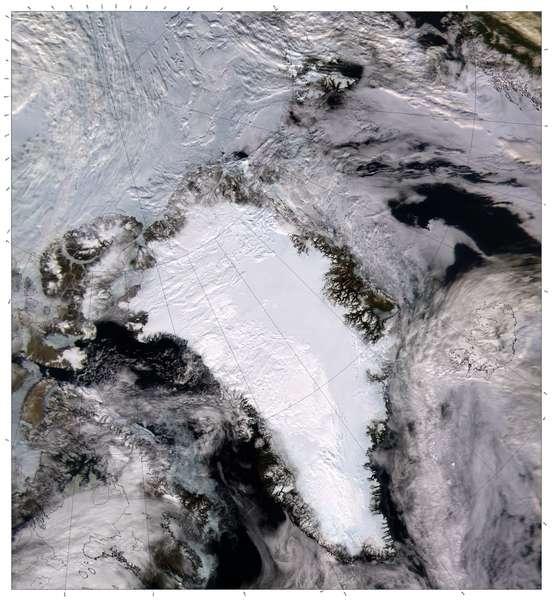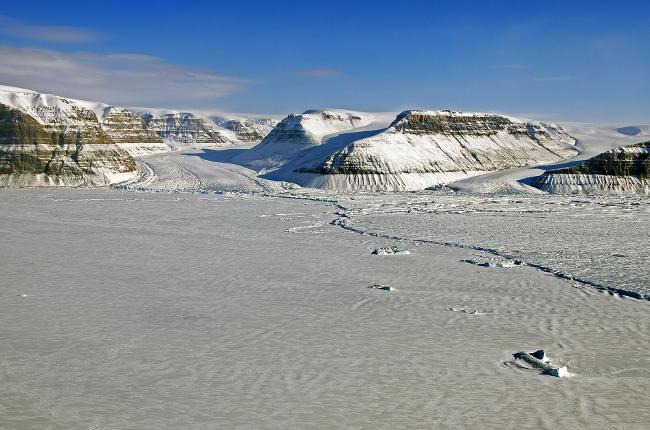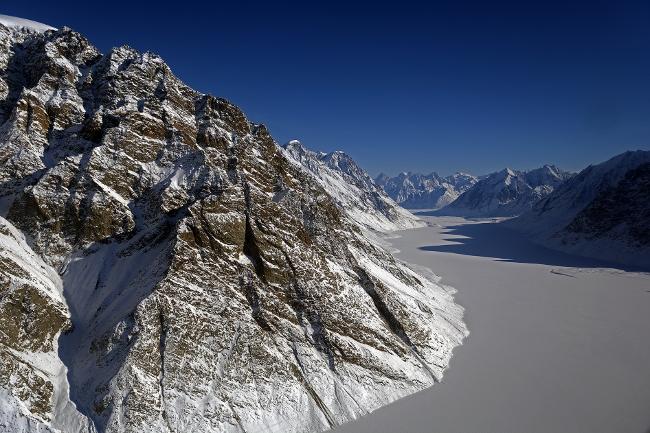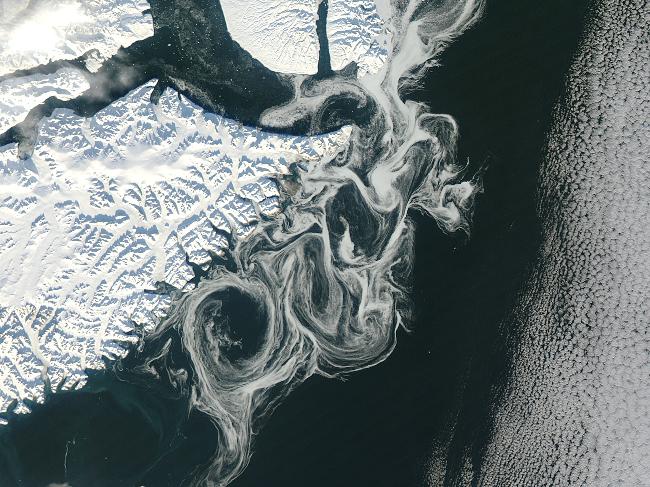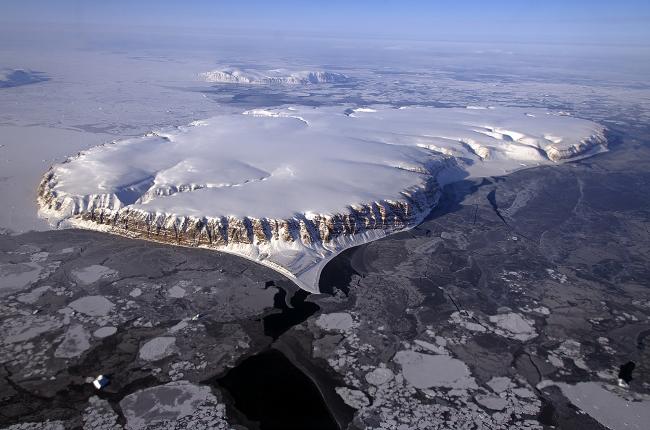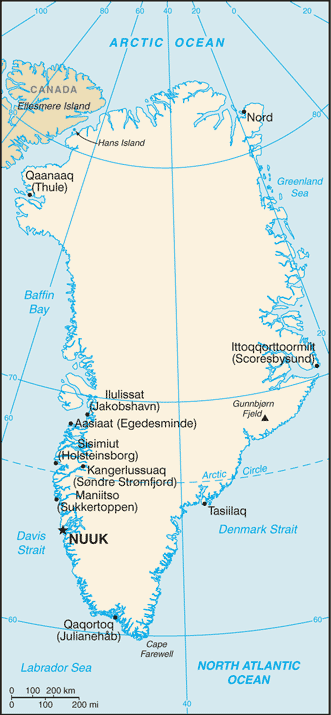Introduction :: GREENLAND
-
Greenland, the world's largest island, is about 81% ice-capped. Vikings reached the island in the 10th century from Iceland; Danish colonization began in the 18th century, and Greenland became an integral part of the Danish Realm in 1953. It joined the European Community (now the EU) with Denmark in 1973 but withdrew in 1985 over a dispute centered on stringent fishing quotas. Greenland remains a member of the Overseas Countries and Territories Association of the EU. Greenland was granted self-government in 1979 by the Danish parliament; the law went into effect the following year. Greenland voted in favor of increased self-rule in November 2008 and acquired greater responsibility for internal affairs when the Act on Greenland Self-Government was signed into law in June 2009. Denmark, however, continues to exercise control over several policy areas on behalf of Greenland, including foreign affairs, security, and financial policy in consultation with Greenland's Self-Rule Government.
Geography :: GREENLAND
-
Northern North America, island between the Arctic Ocean and the North Atlantic Ocean, northeast of Canada
72 00 N, 40 00 W
Arctic Region
total: 2,166,086 sq km
land: 2,166,086 sq km (410,449 sq km ice-free, 1,755,637 sq km ice-covered)
country comparison to the world: 12
slightly more than three times the size of Texas
0 km
44,087 km
territorial sea: 3 nm
exclusive fishing zone: 200 nm or agreed boundaries or median line
continental shelf: 200 nm or agreed boundaries or median line
arctic to subarctic; cool summers, cold winters
flat to gradually sloping icecap covers all but a narrow, mountainous, barren, rocky coast
mean elevation: 1,792 m
elevation extremes: lowest point: Atlantic Ocean 0 m
highest point: Gunnbjorn Fjeld 3,700 m
coal, iron ore, lead, zinc, molybdenum, diamonds, gold, platinum, niobium, tantalite, uranium, fish, seals, whales, hydropower, possible oil and gas
agricultural land: 0.6%
arable land 0%; permanent crops 0%; permanent pasture 0.6%
forest: 0%
other: 99.4% (2011 est.)
NA
settlement concentrated on the southwest shoreline, with limited settlements scattered along the remaining coast; interior is uninhabited
continuous permafrost over northern two-thirds of the island
protection of the arctic environment; preservation of the Inuit traditional way of life, including whaling and seal hunting
dominates North Atlantic Ocean between North America and Europe; sparse population confined to small settlements along coast; close to one-quarter of the population lives in the capital, Nuuk; world's second largest ice sheet after that of Antarctica
People and Society :: GREENLAND
-
57,728 (July 2016 est.)
country comparison to the world: 206
noun: Greenlander(s)
adjective: Greenlandic
Inuit 88%, Danish and other 12% (2010 est.)
Greenlandic (East Inuit) (official), Danish (official), English
Evangelical Lutheran, traditional Inuit spiritual beliefs
0-14 years: 21.26% (male 6,237/female 6,034)
15-24 years: 15.81% (male 4,612/female 4,514)
25-54 years: 41.6% (male 12,597/female 11,416)
55-64 years: 12.43% (male 4,001/female 3,177)
65 years and over: 8.9% (male 2,754/female 2,386) (2016 est.)
population pyramid:

North America
::GREENLAND

Population Pyramid
A population pyramid illustrates the age and sex structure of a country's population and may provide insights about political and social stability, as well as economic development. The population is distributed along the horizontal axis, with males shown on the left and females on the right. The male and female populations are broken down into 5-year age groups represented as horizontal bars along the vertical axis, with the youngest age groups at the bottom and the oldest at the top. The shape of the population pyramid gradually evolves over time based on fertility, mortality, and international migration trends.
For additional information, please see the entry for Population pyramid on the Definitions and Notes page under the References tab.
total: 33.8 years
male: 35 years
female: 32.6 years (2016 est.)
country comparison to the world: 87
-0.02% (2016 est.)
country comparison to the world: 202
14.4 births/1,000 population (2016 est.)
country comparison to the world: 135
8.6 deaths/1,000 population (2016 est.)
country comparison to the world: 78
-6 migrant(s)/1,000 population (2016 est.)
country comparison to the world: 199
settlement concentrated on the southwest shoreline, with limited settlements scattered along the remaining coast; interior is uninhabited
urban population: 86.4% of total population (2015)
rate of urbanization: 0.74% annual rate of change (2010-15 est.)
NUUK (capital) 17,000 (2014)
at birth: 1.05 male(s)/female
0-14 years: 1.03 male(s)/female
15-24 years: 1.02 male(s)/female
25-54 years: 1.1 male(s)/female
55-64 years: 1.26 male(s)/female
65 years and over: 1.15 male(s)/female
total population: 1.1 male(s)/female (2016 est.)
total: 9 deaths/1,000 live births
male: 10.3 deaths/1,000 live births
female: 7.7 deaths/1,000 live births (2016 est.)
country comparison to the world: 144
total population: 72.4 years
male: 69.7 years
female: 75.2 years (2016 est.)
country comparison to the world: 144
2.01 children born/woman (2016 est.)
country comparison to the world: 120
1.67 physicians/1,000 population (2009)
5.8 beds/1,000 population (2009)
improved:
urban: 100% of population
rural: 100% of population
total: 100% of population
unimproved:
urban: 0% of population
rural: 0% of population
total: 0% of population (2015 est.)
improved:
urban: 100% of population
rural: 100% of population
total: 100% of population
unimproved:
urban: 0% of population
rural: 0% of population
total: 0% of population (2015 est.)
NA
NA
NA
Government :: GREENLAND
-
conventional long form: none
conventional short form: Greenland
local long form: none
local short form: Kalaallit Nunaat
note: named by Norwegian adventurer Erik THORVALDSSON (Erik the Red) in 985 in order to entice settlers to the island
part of the Kingdom of Denmark; self-governing overseas administrative division of Denmark since 1979
parliamentary democracy (Parliament of Greenland); part of the Kingdom of Denmark
name: Nuuk (Godthaab)
geographic coordinates: 64 11 N, 51 45 W
time difference: UTC-3 (2 hours ahead of Washington, DC, during Standard Time)
daylight saving time: +1hr, begins last Sunday in March; ends last Sunday in October
note: Greenland has four time zones
4 municipalities (kommuner, singular kommune); Kujalleq, Qaasuitsup, Qeqqata, Sermersooq
note: the North and East Greenland National Park (Avannaarsuani Tunumilu Nuna Allanngutsaaliugaq) and the Thule Air Base in Pituffik (in northwest Greenland) are two unincorporated areas; the national park's 972,000 sq km - about 46% of the island - makes it the largest national park in the world and also the most northerly
none (extensive self-rule as part of the Kingdom of Denmark; foreign affairs is the responsibility of Denmark, but Greenland actively participates in international agreements relating to Greenland)
June 21 (longest day)
previous 1953 (Greenland established as a constituency in the Danish constitution), 1979 (Greenland Home Rule Act); latest 21 June 2009 (Greenland Self-Government Act) (2016)
the laws of Denmark apply where applicable and Greenlandic law applies to other areas
see Denmark
18 years of age; universal
chief of state: Queen MARGRETHE II of Denmark (since 14 January 1972), represented by High Commissioner Mikaela ENGELL (since April 2011)
head of government: Premier Kim KIELSEN (since 30 September 2014)
cabinet: Home Rule Government elected by the Parliament (Landsting) on the basis of the strength of parties
elections/appointments: the monarchy is hereditary; high commissioner appointed by the monarch; premier indirectly elected by Parliament
election results: Kim KIELSEN elected premier; Parliament vote - Kim KIELSEN (S) 34.3%, Sara OLSVIG (IA) 33.2%, Anda ULDUM (D) 11.8%, other 20.7%
description: unicameral Parliament or Inatsisartut (Landsting) (31 seats; members directly elected in multi-seat constituencies by proportional representation vote to serve 4-year terms)
note: two representatives were elected to the Danish Parliament or Folketing on 18 June 2015 (next to be held by June 2019); percent of vote by party - NA; seats by party - Siumut 1, Inuit Ataqatigiit 1
elections: last held on 28 November 2014 (next to be held by 2018)
election results: percent of vote by party - S 34.6%, IA 33.5%, D 11.9%, PN 11.7%, A 6.6%, other 1.7%; seats by party - S 11, IA 11, D 4, PN 3, A 2 (2013)
highest court(s): High Court of Greenland (consists of the presiding professional judge and 2 lay assessors); note - appeals beyond the High Court of Greenland can be heard by the Supreme Court (in Copenhagen)
judge selection and term of office: judges appointed by the monarch upon the recommendation of the Judicial Appointments Council, a 6-member independent body of judges and lawyers; judges appointed for life with retirement at age 70
subordinate courts: Court of Greenland; 18 district or magistrates' courts
Democrats Party or D (Demokraatit) [Randi VESTERGAARD]
Forward Party or S (Siumut) [Kim KIELSEN]
Inuit Community or IA (Inuit Ataqatigiit) [Sara OLSVIG]
Inuit Party or PI (Partii Inuit) [Nikku OLSEN]
Partii Naleraq or PN [Hans ENOKSEN]
Solidarity Party or A (Atassut) [Knud KRISTIANSEN]
other: conservationists; environmentalists; those wanting independence
Arctic Council, ICC, NC, NIB, UPU
none (self-governing overseas administrative division of Denmark): note - Greenland has an office in the Danish Embassy to the US; it also has offices in the Danish consulates of Chicago and New York
none (self-governing overseas administrative division of Denmark); note - the US embassy in Copenhagen has an office devoted to Greenland
two equal horizontal bands of white (top) and red with a large disk slightly to the hoist side of center - the top half of the disk is red, the bottom half is white; the design represents the sun reflecting off a field of ice; the colors are the same as those of the Danish flag and symbolize Greenland's links to the Kingdom of Denmark
polar bear; national colors: red, white
name: "Nunarput utoqqarsuanngoravit" ("Our Country, Who's Become So Old" also translated as "You Our Ancient Land")
lyrics/music: Henrik LUND/Jonathan PETERSEN
note: adopted 1916; the government also recognizes "Nuna asiilasooq" as a secondary anthem
Economy :: GREENLAND
-
The economy remains critically dependent on exports of shrimp and fish, income from resource exploration and extraction, and on a substantial subsidy from the Danish Government. The subsidy was budgeted to be about $535 million in 2015, approximately 56% of government revenues that year.
The public sector, including publicly owned enterprises and the municipalities, plays the dominant role in Greenland's economy. Greenland's real GDP contracted about 5% from 2012 to 2014. Real growth is projected for 2015 and 2016 due to increasing world prices for fish and shellfish, public construction activities, and to a small degree from increased revenues from small-scale mining.
During the last decade the Greenland Home Rule Government pursued conservative fiscal and monetary policies, but public pressure has increased for better schools, health care, and retirement systems. The public budget exhibited a deficit of 2% of GDP in 2014, but public debt remains low at about 5% of GDP.
The Greenlandic economy has benefited from increasing catches and exports of shrimp, Greenland halibut and, more recently, mackerel. Due to Greenland's continued dependence on exports of fish - which accounted for 91% of exports in 2015 - the economy remains very sensitive to external demand and price fluctuations.
The Greenlandic economy is expected to expand in 2016, but significant challenges face the island. High unemployment, structural challenges stemming from low levels of qualified labor, geographic dispersion, an undiversified economy, the long-term sustainability of the public budget, and a declining population due to emigration. Catches in fisheries have been declining in recent years and a reversal in prices will quickly lead to vulnerabilities. Hydrocarbon exploration has ceased with declining oil prices and currently only three mines are under development. The island has potential for natural resource exploitation with rare-earth, uranium, and iron ore mineral projects proposed.
Tourism offers another avenue of economic growth for Greenland, with increasing numbers of cruise lines now operating in Greenland's western and southern waters during the peak summer tourism season.
$2.173 billion (2014 est.)
$2.154 billion (2013 est.)
$2.165 billion (2012 est.)
note: data are in 2011 US dollars
country comparison to the world: 193
$2.16 billion (2011 est.)
0.9% (2014 est.)
-0.5% (2013 est.)
1.5% (2012 est.)
country comparison to the world: 181
$37,900 (2008 est.)
$38,100 (2007 est.)
country comparison to the world: 46
agriculture: 13.9%
industry: 19.2%
services: 67% (2012 est.)
sheep, cow, reindeer, fish
fish processing (mainly shrimp and Greenland halibut); gold, zinc, anorthosite and ruby mining; handicrafts, hides and skins, small shipyards
NA%
26,990 (2012 est.)
country comparison to the world: 206
agriculture: 13.9%
industry: 19.2%
services: 67% (2012 est.)
9.4% (2013 est.)
4.2% (2010 est.)
country comparison to the world: 108
9.2% (2007 est.)
lowest 10%: NA%
highest 10%: NA%
revenues: $1.72 billion
expenditures: $1.68 billion (2010)
79.6% of GDP (2010)
country comparison to the world: 4
1.9% of GDP (2010)
country comparison to the world: 15
calendar year
1.8% (2012 est.)
2.8% (2011 est.)
country comparison to the world: 102
$384.3 million (2010)
$358 million (2009)
country comparison to the world: 177
fish and fish products 91% (2015 est.)
Denmark 51.6%, China 11.1%, Japan 9.1%, Russia 7.2% (2015)
$814.2 million (2010)
$726 million (2009)
country comparison to the world: 184
machinery and transport equipment, manufactured goods, food, petroleum products
Denmark 67.1%, Sweden 14.1%, Iceland 5.1% (2015)
$36.4 million (2010)
$58 million (2009)
country comparison to the world: 196
Danish kroner (DKK) per US dollar -
6.865 (2016 est.)
6.7236 (2015 est.)
6.7236 (2014 est.)
5.3687 (2013 est.)
5.79 (2012 est.)
Economy :: GREENLAND
-
The economy remains critically dependent on exports of shrimp and fish, income from resource exploration and extraction, and on a substantial subsidy from the Danish Government. The subsidy was budgeted to be about $535 million in 2015, approximately 56% of government revenues that year.
The public sector, including publicly owned enterprises and the municipalities, plays the dominant role in Greenland's economy. Greenland's real GDP contracted about 5% from 2012 to 2014. Real growth is projected for 2015 and 2016 due to increasing world prices for fish and shellfish, public construction activities, and to a small degree from increased revenues from small-scale mining.
During the last decade the Greenland Home Rule Government pursued conservative fiscal and monetary policies, but public pressure has increased for better schools, health care, and retirement systems. The public budget exhibited a deficit of 2% of GDP in 2014, but public debt remains low at about 5% of GDP.
The Greenlandic economy has benefited from increasing catches and exports of shrimp, Greenland halibut and, more recently, mackerel. Due to Greenland's continued dependence on exports of fish - which accounted for 91% of exports in 2015 - the economy remains very sensitive to external demand and price fluctuations.
The Greenlandic economy is expected to expand in 2016, but significant challenges face the island. High unemployment, structural challenges stemming from low levels of qualified labor, geographic dispersion, an undiversified economy, the long-term sustainability of the public budget, and a declining population due to emigration. Catches in fisheries have been declining in recent years and a reversal in prices will quickly lead to vulnerabilities. Hydrocarbon exploration has ceased with declining oil prices and currently only three mines are under development. The island has potential for natural resource exploitation with rare-earth, uranium, and iron ore mineral projects proposed.
Tourism offers another avenue of economic growth for Greenland, with increasing numbers of cruise lines now operating in Greenland's western and southern waters during the peak summer tourism season.
$2.173 billion (2014 est.)
$2.154 billion (2013 est.)
$2.165 billion (2012 est.)
note: data are in 2011 US dollars
country comparison to the world: 193
$2.16 billion (2011 est.)
0.9% (2014 est.)
-0.5% (2013 est.)
1.5% (2012 est.)
country comparison to the world: 181
$37,900 (2008 est.)
$38,100 (2007 est.)
country comparison to the world: 46
agriculture: 13.9%
industry: 19.2%
services: 67% (2012 est.)
sheep, cow, reindeer, fish
fish processing (mainly shrimp and Greenland halibut); gold, zinc, anorthosite and ruby mining; handicrafts, hides and skins, small shipyards
NA%
26,990 (2012 est.)
country comparison to the world: 206
agriculture: 13.9%
industry: 19.2%
services: 67% (2012 est.)
9.4% (2013 est.)
4.2% (2010 est.)
country comparison to the world: 108
9.2% (2007 est.)
lowest 10%: NA%
highest 10%: NA%
revenues: $1.72 billion
expenditures: $1.68 billion (2010)
79.6% of GDP (2010)
country comparison to the world: 4
1.9% of GDP (2010)
country comparison to the world: 15
calendar year
1.8% (2012 est.)
2.8% (2011 est.)
country comparison to the world: 102
$384.3 million (2010)
$358 million (2009)
country comparison to the world: 177
fish and fish products 91% (2015 est.)
Denmark 51.6%, China 11.1%, Japan 9.1%, Russia 7.2% (2015)
$814.2 million (2010)
$726 million (2009)
country comparison to the world: 184
machinery and transport equipment, manufactured goods, food, petroleum products
Denmark 67.1%, Sweden 14.1%, Iceland 5.1% (2015)
$36.4 million (2010)
$58 million (2009)
country comparison to the world: 196
Danish kroner (DKK) per US dollar -
6.865 (2016 est.)
6.7236 (2015 est.)
6.7236 (2014 est.)
5.3687 (2013 est.)
5.79 (2012 est.)
Energy :: GREENLAND
-
300 million kWh (2014 est.)
country comparison to the world: 182
300 million kWh (2014 est.)
country comparison to the world: 186
0 kWh (2013 est.)
country comparison to the world: 170
0 kWh (2013 est.)
country comparison to the world: 178
96,000 kW (2014 est.)
country comparison to the world: 177
100% of total installed capacity (2012 est.)
country comparison to the world: 25
0% of total installed capacity (2012 est.)
country comparison to the world: 147
0% of total installed capacity (2012 est.)
country comparison to the world: 192
0% of total installed capacity (2012 est.)
country comparison to the world: 208
0 bbl/day (2015 est.)
country comparison to the world: 142
0 bbl/day (2013 est.)
country comparison to the world: 174
0 bbl/day (2013 est.)
country comparison to the world: 166
0 bbl (1 January 2016 es)
country comparison to the world: 178
0 bbl/day (2013 est.)
country comparison to the world: 177
6,000 bbl/day (2014 est.)
country comparison to the world: 169
0 bbl/day (2013 est.)
country comparison to the world: 184
4,633 bbl/day (2013 est.)
country comparison to the world: 169
0 cu m (2013 est.)
country comparison to the world: 177
0 cu m (2013 est.)
country comparison to the world: 150
0 cu m (2013 est.)
country comparison to the world: 160
0 cu m (2013 est.)
country comparison to the world: 107
0 cu m (1 January 2014 es)
country comparison to the world: 174
600,000 Mt (2013 est.)
country comparison to the world: 179
Communications :: GREENLAND
-
total subscriptions: 16,000
subscriptions per 100 inhabitants: 28 (July 2015 est.)
country comparison to the world: 191
total: 61,000
subscriptions per 100 inhabitants: 106 (July 2015 est.)
country comparison to the world: 200
general assessment: adequate domestic and international service provided by satellite, cables, and microwave radio relay; totally digital since 1995
domestic: microwave radio relay and satellite; the fundamental telecommunications infrastructure consists of a digital radio link from Nanortalik in south Greenland to Uummannaq in north Greenland; satellites cover north and east Greenland for domestic and foreign
international: country code - 299; satellite earth stations - 15 (12 Intelsat, 1 Eutelsat, 2 Americom GE-2 (all Atlantic Ocean)) (2015)
the Greenland Broadcasting Company provides public radio and TV services throughout the island with a broadcast station and a series of repeaters; a few private local TV and radio stations; Danish public radio rebroadcasts are available (2015)
.gl
total: 39,000
percent of population: 67.6% (July 2015 est.)
country comparison to the world: 192
Transportation :: GREENLAND
-
number of registered air carriers: 1 (registered in Denmark)
inventory of registered aircraft operated by air carriers: 8 (registered in Denmark) (2015)
OY-H (2016)
15 (2013)
country comparison to the world: 147
total: 10
2,438 to 3,047 m: 2
1,524 to 2,437 m: 1
914 to 1,523 m: 1
under 914 m: 6 (2013)
total: 5
1,524 to 2,437 m: 1
914 to 1,523 m: 2
under 914 m: 2 (2013)
note: although there are short roads in towns, there are no roads between towns; inter-urban transport is either by sea or by air (2015)
registered in other countries: 1 (Denmark 1) (2010)
country comparison to the world: 156
major seaport(s): Sisimiut
Military and Security :: GREENLAND
-
no regular military forces; the Government of Denmark has responsibility for defense; as such the Danish military’s Joint Arctic Command is responsible for territorial defense of Greenland (2016)
defense is the responsibility of Denmark
Transnational Issues :: GREENLAND
-
managed dispute between Canada and Denmark over Hans Island in the Kennedy Channel between Canada's Ellesmere Island and Greenland; Denmark (Greenland) and Norway have made submissions to the Commission on the Limits of the Continental Shelf (CLCS) and Russia is collecting additional data to augment its 2001 CLCS submission










